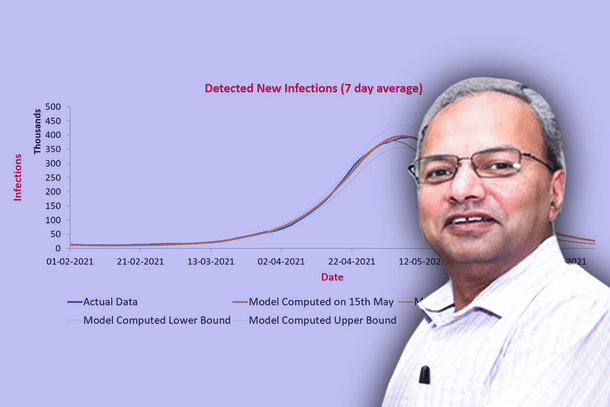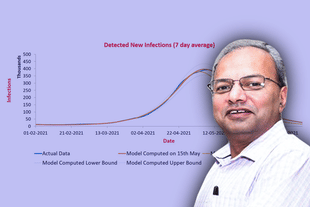News Brief
Explained: SUTRA Model's Third Wave Predictions — How, When, What
Swarajya Staff
Jul 03, 2021, 10:43 AM | Updated 10:43 AM IST
Save & read from anywhere!
Bookmark stories for easy access on any device or the Swarajya app.


The SUTRA model for Covid-19 pandemic predicts a third wave to occur between October and November this year.
SUTRA, which stands for Susceptible, Undetected, Tested (positive), and Removed Approach, is a mathematical model for pandemics developed by M Agrawal (IIT Kanpur), M Kanitkar (Integrated Defence Staff), and M Vidyasagar (IIT Hyderabad).
The model is unique as it incorporates for a large numbers of undetected asymptomatic patients apart from the known asymptomatic and infected cases.
The model also explicitly takes into account the spatial spread of a pandemic over time, through a parameter called "reach."
Using the daily new infections data series, the model estimates the values of all the parameters. Readers can find the simulations for India, several states and districts on a portal developed by CRUBN, a company incubated at IIT Kanpur developing blockchain-based e-governance solutions in India.
The model is being used to track the progression of the Covid-19 pandemic in India.
According to Professor M Agrawal, in the predictions for the third wave, their team had to take into account one — the loss of immunity in the recovered population — and second — vaccination induced immunity — during an analysis on how these would develop in the future.
He said that these two factors were incorporated in the model by suitably changing the contact rate and reach parameters.
"We went through the studies done in the past on loss of immunity and used conservative numbers for them. Similarly, we looked at the projected vaccination rate over the next few months, included the effects of vaccine-hesitancy, and arrived at month-wise estimates for vaccination," said Professor Agarwal in a Twitter thread.
The team had to also take into account certain "imponderables" like the possibility of the rise of a new, more infectious, variant of the Covid-19 virus; or to what degree people would abandon Covid-appropriate behaviour as the second wave ebbs (like it happened in March this year).
The model predicts the second wave to reach the lowest point by August-end or early September (Model projections computed on 30 June 2021 and accuracy of projections is within ± 10 per cent).
"One can only make guesses, which may be completely wrong. Hence, it is better to compute a few what-if scenarios," said the Professor.
The team came up with three different scenarios:
Optimistic — life goes back to normal by August, and there is no new mutant
Intermediate — optimistic scenario assumptions but vaccination is 20 per cent less effective
Pessimistic — intermediate scenario assumptions but a 25 per cent more infectious mutant spreads in August (it is not delta+, which is not more infectious than delta)
Here are plots for the three scenarios. Blue curve is actual data. Orange one is model prediction until May. Dotted curves are three scenarios plotted from June.

One can see from the graphs that the predictions for the optimistic (green dotted line) and intermediate (orange dotted line) case scenarios are quite close.
This suggests that up to 20 per cent changes in vaccine efficacy do not have a significant impact. Therefore, one, people should get vaccinated, and two, they should also continue to practice physical distancing.
The pessimistic scenario (purple dotted line) has a much higher case load, showing that a faster spreading mutant has a bigger impact. However, it is nowhere as big as the second wave.
"So the bottom line is: if there is no significantly faster spreading mutant, the third wave will be a ripple. And if there is such a mutant, the third wave will be comparable to the first one," said Professor Agarwal.
"However, if there is an immunity-escape mutant, all the above scenarios will be invalid," he added.





